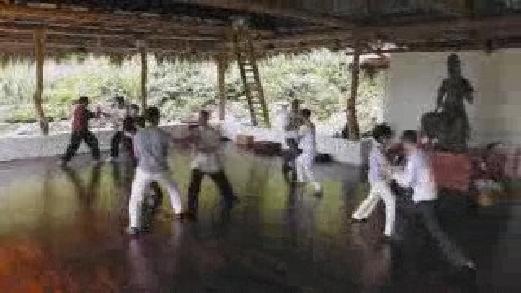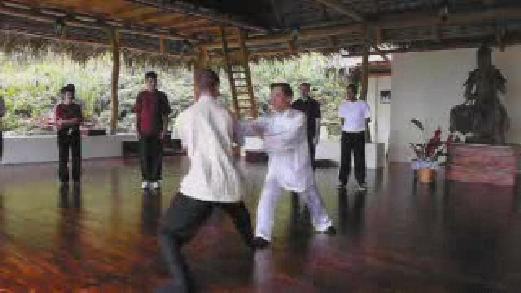DEVELOPING COMBAT SKILLS IN PUSHING HANDS

It is precisely for this reason of developing skills, that techniques are purposely reduced to the bare minimum, in order that students can free their mind from thinking what techniques to use so as to focus on their skills. In stationary Pushing Hands, for example, only one technique, “White Snake Shoots Venom”, is used by the initiator, and only one technique, “Immortal Waves Sleeves”, is used by the responder. In mobile Pushing Hands, the initiator only uses “Open Window to Look at Moon”, and the responder “Immortal Waves Sleeves”.
When an initiator attacks, the responder does not block or go against the momentum of the attack. He “yields” to the attack, deflects it, and turns it against the opponent, all flowing with the opponent's momentum. This implements the Taijiquan principles of “using minimum force against maximum strength”, and “using an opponent's strength against himself”.
Neutralizing an Opponent's Force

“Hua jin”, or neutralizing an opponent's force, is a very important skill in Taijiquan. It is often, though incompletely, translated as “yielding”.
Short Range and Medium Range

If an opponent's attack is short range, you can neutralize by using only hand movement, If the attack is medium range, you use both hand-movement and body-movement. If the attack is long range (shown in the next video clip), you use hand-movement, body-movement and leg-movement.
Long Range Attack

When the attack is long range, using just hand-movement and body-movement is insufficient; you need to use leg-movement to move away into another stance.
Securing a Tactical Advantage in Leg-Mode

When an opponent rolls forward, you roll back. When he steps forward, you step back. In this way you maintain the same leg-mode as he does. But if you wish to use a different leg-mode as his, such as for a tactical advantage, you can step back as he rolls forward, or roll back as he steps forward.
Securing a Tactical Advantage in Side-Attack

You may also secure a tactical advantage by attacking your opponent from his sides. The practitioner pushes from his back leg, and not from his shoulders.
Neutralizing an opponent's Advantage

As an opponent attacks from his left side, you can neutralize his advantage by moving to his left side too.
Pushing from the Sides

Now you push from his right side. You must cover your opponent's arms to prevent him from counter-attacking. Your opponent responds using appropriate footwork, body-movement and hand-technique.
Enjoying Pushing Hands

Participants enjoy themselves Pushing Hands, applying the techniques they have just learnt. Some of them are fresh beginners.
Getting to the Back of your Opponent

Here is how you can get to the back of your opponent. You need to prepare your foot-position and cover your opponent as you move to his back.
Neutralizing an Opponent's Attack from the Back

Here is how to neutralize your opponent's attack from the back, and counter-attack. If he is not skillful, he would be hit by you as you complete your attack.
Importance of Footwork

Footwork is very important in Pushing Hands, as shown in this video clip. Participants enjoy themselves.
Spontaneity of Movements

In Pushing Hands, as in free sparring or actual combat, movements must be effective as well as spontaneous while maintaining correct form and executed with good force and speed. A fresh beginner can move effectively and spontaneously after systematic training for just two days.
Developing Combat Skills in Pushing Hands from Wong Kiew Kit on Vimeo.
LINKS
Wahnam Taijiquan Training from Basics to Free Sparring
- Part 1 — The Secret of the Internal Force Masters
- Part 2 — Cloud Hands: From Chi Flow Movements to Patterns and Sets
- Part 3 — Developing Combat Skills in Pushing Hands
- Part 4 — Practicing Combat Techniques in Striking Hands
- Part 5 — Applying Kicks, Throws and Grips in Striking Hands
- Part 6 — Combat Sequences 1 and 2: Top, Middle, Bottom and Sides
- Part 7 — Combat Sequence 3: Pressing Attacks and How to Defend against Them
- Part 8 — Combat Sequences 4 and 5: Thrust Kick, Side Kick and Whirlwind Kick
- Part 9 — Combat Sequence 6: Felling Opponents with Carrying Tiger Back to Mountain
- Part 10 — Combat Seqeences 7 and 8: Chin-Na or Gripping Attacks and their Defences
- Part 11 — The Eight Simplified Combat Sequences of Wahnam Taijiquan
- Part 12 — From Guided Sparring to Free Sparring in Wahnam Taijiquan
Courses and Classes
